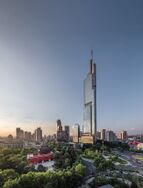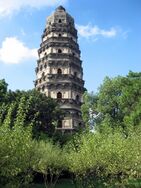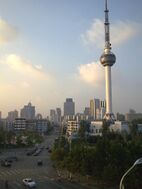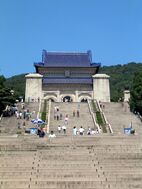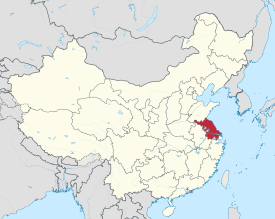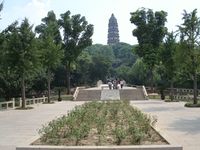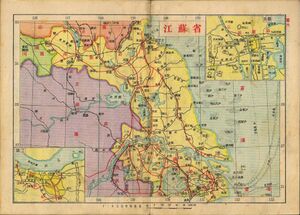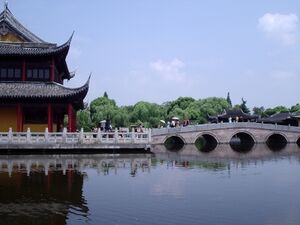جيانغسو
| ||||||||||||||||||||||||||||||||||||||||||||||||||||||||||||||||||||||||||||||||||||
| ||||||||||||||||||||||||||||||||||||||||||||||||||||||||||||||||||||||||||||||||||||
جيانغسو أو جيانگسو (UK /dʒæŋˈsuː/;[4] الأمريكي /ˈdʒjɑːŋˈsuː/ [5] صينية: 江苏 �; pinyin: Jiāngsū ؛ تهجي خريطة البريد: Kiangsu أو Chiangsu ؛ إنگليزية: Jiangsu) هي مقاطعة ساحلية شرقية في جمهورية الصين الشعبية. وهي واحدة من المقاطعات الرائدة في مجالات التمويل والتعليم والتكنولوجيا والسياحة، وعاصمتها هي نانجينگ. جيانگسو هي ثالث أصغر، ولكن خامس الأكبر تعداداً و الأكثر اكتظاظاً بالسكان بين الـ 23 مقاطعة في جمهورية الصين الشعبية. تتمتع جيانگسو بأعلى ن.م.ا. للفرد بين المقاطعات الصينية وثاني أعلى ن.م.ا. بين المقاطعات، بعد گوانگدونگ.[6] تحد جيانگسو شاندونگ في الشمال، آنهوي إلى الغرب، و ژىجيانگ و شانغهاي إلى الجنوب. ولجيانگسو شريط ساحلي يزيد طوله عن 1000 كم على البحر الأصفر، ويمر نهر يانگتسى في الجزء الجنوبي من المقاطعة.
منذ أسرتي سوي وتانگ، كانت جيانگسو مركزاً اقتصادياً وتجارياً على مستوى الأمة، ويرجع ذلك جزئياً إلى إنشاء القناة الكبرى. ومدن مثل نانجينگ، سوژو، ووشي، و چانگژو، وشانغهاي (فـُصِلَت عن جيانگسو في 1927) هي كلها مراكز اقتصادية صينية كبرى. ومنذ بدء الإصلاحات الاقتصادية في 1990، أصبحت جيانگسو بؤرة للتنمية الاقتصادية. It is widely regarded as one of China's most developed provinces, when measured by its Human Development Index (HDI).[3] Its 2021 nominal GDP per capita reached RMB 137,300 (US$21,287), becoming the first province in China to reach $20,000 mark.[7]
Jiangsu is home to many of the world's leading exporters of electronic equipment, chemicals and textiles.[8] It has also been China's largest recipient of foreign direct investment since 2006. Its 2021 nominal GDP was more than RMB 11.64 trillion (US$1.80 trillion), which is the fifth-highest of all country subdivisions.[7] If it were a country, it would be the tenth-largest economy as of 2021 as well as the 19th most populous.[9]
Jiangsu is also one of the leading provinces in research and education in China. As of 2022, Jiangsu hosts 168 institutions of higher education, ranking first of all Chinese provinces.[10] Jiangsu has many highly ranked educational institutions,[11] with 16 number of universities listed in the Double First-Class Universities, ranking second after Beijing. As of 2020, two major cities in Jiangsu ranked in the world's top 50 (Nanjing 8th and Suzhou 45th) cities by scientific research output, as tracked by the Nature Index.[12]
. . . . . . . . . . . . . . . . . . . . . . . . . . . . . . . . . . . . . . . . . . . . . . . . . . . . . . . . . . . . . . . . . . . . . . . . . . . . . . . . . . . . . . . . . . . . . . . . . . . . . . . . . . . . . . . . . . . . . . . . . . . . . . . . . . . . . . . . . . . . . . . . . . . . . . . . . . . . . . . . . . . . . . . .
الاسم
Jiangsu's name is a compound of the first elements of the names of the two cities of Jiangning (now Nanjing) and Suzhou. The abbreviation for this province is "苏" (Sū), the second character of its name.[13]
التاريخ
During the earliest Chinese dynasties, the area that is now Jiangsu was far away from the center of Chinese civilization, which was in the northwest Henan; it was home of the Huai Yi (淮夷), an ancient ethnic group. During the Zhou dynasty more contact was made, and eventually the state of Wu appeared in southern Jiangsu, one of the many hundreds of states that existed across northern and central China at that time. Near the end of the Spring and Autumn period, Wu became a great power under King Helu of Wu, and defeated in 484 BC the state of Qi, a major power in the north in modern-day Shandong province, and contest for the position of overlord over all states of China. The state of Wu was subjugated in 473 BC by the state of Yue, another state that had emerged to the south in modern-day Zhejiang province. Yue was in turn subjugated by the powerful state of Chu from the west in 333 BC. Eventually the state of Qin swept away all the other states, and unified China in 221 BC.[14]
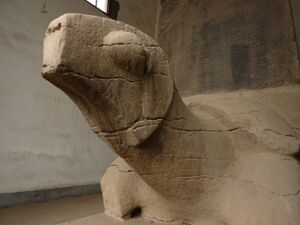
Under the reign of the Han dynasty (206 BC to 220 AD), Jiangsu was removed from the centers of civilization in the North China Plain, and was administered under two zhou (provinces): Xu Province in the north, and Yang Province in the south. During the Three Kingdoms period, southern Jiangsu became the base of the Eastern Wu (222 to 280), whose capital, Jianye (later renamed to Jiankang), is modern Nanjing. When nomadic invasions overran northern China in the 4th century, the imperial court of the Jin dynasty moved to Jiankang. Cities in southern and central Jiangsu swelled with the influx of migrants from the north. Jiankang remained as the capital for four successive Southern dynasties and became the largest commercial and cultural center in China.[15]
After the Sui dynasty united the country in 581, the political center of the country shifted back to the north, but the Grand Canal was built through Jiangsu to link the Central Plain with the prosperous Yangtze Delta. The Tang dynasty (618–907) relied on southern Jiangsu for annual deliveries of grain. It was during the Song dynasty (960–1279), which saw the development of a wealthy mercantile class and emergent market economy in China, that Jiangnan (southern Jiangsu, Shanghai, and adjacent areas) emerged as a center of trade. From then onwards, major cities like Suzhou or Yangzhou, would be synonymous with opulence and luxury in China. Today the region remains one of the richest parts of China.
The Jurchen Jin dynasty gained control of North China in 1127 during the Jin-Song wars, and Huai River, which used to cut through north Jiangsu to reach the Yellow Sea, was the border between the north, under the Jin, and the south, under the Southern Song dynasty. The Mongols took control of China in the thirteenth century. The Ming dynasty, which was established in 1368 after driving out the Mongols who had occupied China, initially put its capital in Nanjing. Regions surrounding Nanjing, corresponding to Jiangsu and Anhui today, were designated as the Nanzhili province (literally "southern directly governed"). Following a coup by Zhu Di (later, the Yongle Emperor), however, the capital was moved to Beijing, far to the north, although Nanjing kept its status as the southern capital. In late Ming, Jiangnan continued to be an important center of trade in China; some historians see in the flourishing textiles industry at the time incipient industrialization and capitalism, a trend that was however aborted.
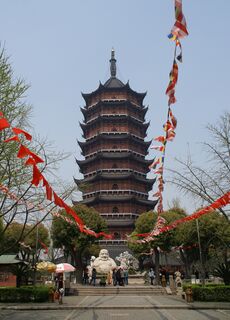
The Qing dynasty converted Nanzhili to "Jiangnan province"; in 1666 Jiangsu and Anhui were split apart as separate provinces. Jiangsu's borders have been for the most part stable since then.
With the start of the Western incursion into China in the 1840s, the rich and mercantile Yangtze river delta was increasingly exposed to Western influence; Shanghai, originally an unremarkable little town of Jiangsu, quickly developed into a metropolis of trade, banking, and cosmopolitanism, and was split out later as an independent municipality. Jiangnan also figures strongly in the Taiping Rebellion (1851 – 1864), a massive and deadly rebellion that attempted to set up a Christian theocracy in China; it started far to the south, in Guangdong province, swept through much of South China, and by 1853, had established Nanjing as its capital, renamed as Tianjing (天京 "Heavenly Capital").
جمهورية الصين تأسست عام 1912، وسرعان ما تمزقت الصين بين أمراء الحرب. تقلب الحكام على جيانگسو عدة مرات، ولكن في أبريل 1927 چيانگ كاي-شـِك أسس حكومة في نانجينگ؛ وسرعان ما تمكن من توحيد معظم الصين تحت سيطرته. إلا أن هذا التوحيد أحبطته الحرب الصينية اليابانية الثانية، التي استعر اوارها عام 1937؛ وفي 13 ديسمبر، 1937، سقطت نانجينگ، ومجموع الفظائع التي ارتكبتها القوات اليابانية المحتلة على مدى الثلاث شهور التالية صارت تسمى مذبحة نانجينگ. وأصبحت نانجينگ مقراً للحكومة العميلة لشرق الصين تحت قيادة وانگ جينگويْ، وبقيت جيانگسو تحت الاحتلال حتى نهاية الحرب في 1945.
بعد الحرب عادت نانجينگ مرة أخرى عاصمة لجمهورية الصين، إلا أن الحرب الأهلية الصينية بدأت بين حكومة الكومينتانگ والقوات الشيوعية، المتمركزة في الشمال وخاصة في منشوريا. حملة هوايهاي الحاسمة نشبت في شمال جيانگسو وفيها انهزمت قوات الكومينتانگ، وسرعان ما أصبح في إمكان الشيوعيين عبور نهر يانگتسي ويستولوا على نانجينگ. الكومينتانگ فروا شمالاً، ليستقروا في نهاية المطاف في تايپـِيْ، التي منها تستمر جمهورية الصين في إدارة تايوان والجزر المحيطة بها، إلا أنها تواصل الإدعاء (على الأقل فنياً) بأن نانجينگ هي عاصمتها المستحقة.
بعد استيلاء الشيوعيين على الحكم في الصين، اتخذوا بكين عاصمة للصين، وخفـَّضوا مكانة نانجينگ إلى عاصمة مقاطعة جيانگسو.
الجغرافيا
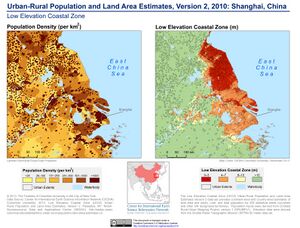
يصب نهر يانگتسي" عبر روافده الكثيرة في "بحر الصين" ويترك خلفه رواسب من الطين، تتراكم هذه الرواسب وتمتد إلى جهة البحر مشكلة مناطق طبيعية جديدة. أغلب الشواطئ الموجودة في المنطقة رملية. تكثر السبخات (مستنقعات شديدة الملوحة) فيها. تتواجد مظاهر المياه في كل مكان: الوديان والثغور البحرية، البحيرات ("هونگتسي"، "قاويو هو") والأهوار (بحيرات تتشكل على مقربة من البحر)، قنوات الري ثم القناة الكبيرة (وهي مجموعة من الأنهر تربط بين "هانگتشو" في الجنوب بـ"بكين" في الشمال). تضم المقاطعة أغلب مناطق "دلتا اليانگتسي".
الإقتصاد
تتميز "جيانگسو" بكثافتها السكانية العالية (.... ن/كلم²). تعتبر من أهم المناطق الزرعية في الـصين. الأرو من أهم المحاصيل الزراعية إلى جانب القمح، الصويا، المزروعات الزيتية (تستخرج منها الزيوت الغذائية)، القطن، التبغ والشاي. تعتمد المنطقة على تربية المواشي (الخنازير، البط) أيضا. من بين النشاطات الإقتصادية الأخرى هناك: تربية دودة القز (الحرير)، الصيد، وتربية الثروات البحرية في الأحواض.
الصناعات
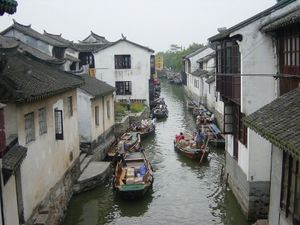
من بين الثروات المعدنية التي تزخر بها المنطقة: الفحم، الفسفاط والملح. تعتبر "جيانغسو" مركزا للصناعات الخفيفة (الأجهزة الإلكترونية) وتتواجد فيها أكبر مصانع منتوجات النسيج في الصين (القطن والحرير). من بين القطاعات الأخرى هناك الحديد والصلب، الكيماويات والميكانيك. مدينة "نانجينگ" هي أكبر مراكز الأنتاج الصناعي في البلاد. نهر يانگتسي" والقناة الكبيرة هما شريان المواصلات (النهرية) والتجارة في المنطقة.
. . . . . . . . . . . . . . . . . . . . . . . . . . . . . . . . . . . . . . . . . . . . . . . . . . . . . . . . . . . . . . . . . . . . . . . . . . . . . . . . . . . . . . . . . . . . . . . . . . . . . . . . . . . . . . . . . . . . . . . . . . . . . . . . . . . . . . . . . . . . . . . . . . . . . . . . . . . . . . . . . . . . . . . .
المدن
هذه قائمة بأهم المدن:
التقسيمات الادارية
تنقسم جيانگسو إلى ثلاثة عشر prefecture-level divisions، وكل prefecture-level cities:
| الخريطة | # | الاسم | هانزي | هانيو پنين | المركز الاداري |
|---|---|---|---|---|---|
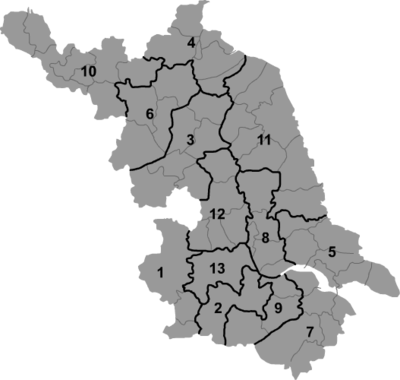
| |||||
| — Sub-provincial city — | |||||
| 1 | نانجينگ | 南京市 | Nánjīng Shì | Xuanwu District | |
| — Prefecture-level city — | |||||
| 2 | چانگژو | 常州市 | Chángzhōu Shì | Zhonglou District | |
| 3 | هوايآن | 淮安市 | Huái'ān Shì | Qinghe District | |
| 4 | ليانيونگأنگ | 连云港市 | Liányúngǎng Shì | Xinpu District | |
| 5 | نانتونگ | 南通市 | Nántōng Shì | Chongchuan District | |
| 6 | سوچيان | 宿迁市 | Sùqiān Shì | Sucheng District | |
| 7 | سوژو | 苏州市 | Sūzhōu Shì | Jinchang District | |
| 8 | تايژو | 泰州市 | Tàizhōu Shì | Hailing District | |
| 9 | ووشي | 无锡市 | Wúxī Shì | Chong'an District | |
| 10 | شوژو | 徐州市 | Xúzhōu Shì | Yunlong District | |
| 11 | Yancheng | 盐城市 | Yánchéng Shì | Tinghu District | |
| 12 | يانگژو | 扬州市 | Yángzhōu Shì | Guangling District | |
| 13 | ژنگجيانگ | 镇江市 | Zhènjiāng Shì | Jingkou District | |
The thirteen prefecture-level divisions of Jiangsu are subdivided into 106 county-level divisions (54 districts, 27 county-level cities, and 25 counties). Those are in turn divided into 1488 township-level divisions (1078 towns, 122 townships, one ethnic township, and 287 subdistricts).
انظر List of administrative divisions of Jiangsu for a complete list of county-level divisions.
المناطق الحضرية
| Population by urban areas of prefecture & county cities | |||||
|---|---|---|---|---|---|
| # | المدينة | Urban area[16] | District area[16] | City proper[16] | Census date |
| 1 | Nanjing[أ] | 5,827,888 | 7,165,292 | 8,003,744 | 2010-11-01 |
| (1) | Nanjing (new districts)[أ] | 410,298 | 838,452 | see Nanjing | 2010-11-01 |
| 2 | Suzhou [ب] | 3,302,152 | 4,072,081 | 10,459,890 | 2010-11-01 |
| (2) | Suzhou (new district)[ب] | 781,771 | 1,273,880 | see Suzhou | 2010-11-01 |
| 3 | Wuxi | 2,757,736 | 3,543,719 | 6,374,399 | 2010-11-01 |
| 4 | Changzhou[ت] | 2,257,376 | 3,290,918 | 4,592,431 | 2010-11-01 |
| (4) | Changzhou (new district)[ت] | 275,185 | 551,991 | see Changzhou | 2010-11-01 |
| 5 | Xuzhou[ث] | 1,735,166 | 1,967,214 | 8,577,225 | 2010-11-01 |
| (5) | Xuzhou (new district)[ث] | 479,629 | 1,086,564 | see Xuzhou | 2010-11-01 |
| 6 | Nantong | 1,612,385 | 2,274,113 | 7,283,622 | 2010-11-01 |
| 7 | Huai'an[ج] | 1,523,655 | 2,635,406 | 4,801,662 | 2010-11-01 |
| (7) | Huai'an (new district)[ج] | 146,359 | 326,459 | see Huai'an | 2010-11-01 |
| 8 | Yancheng[ح] | 1,136,826 | 1,615,836 | 7,262,200 | 2010-11-01 |
| (8) | Yancheng (new district)[ح] | 347,389 | 706,662 | see Yancheng | 2010-11-01 |
| 9 | Kunshan | 1,118,617 | 1,644,860 | see Suzhou | 2010-11-01 |
| 10 | Yangzhou[خ] | 1,077,531 | 1,392,563 | 4,460,066 | 2010-11-01 |
| (10) | Yangzhou (new district)[خ] | 506,706 | 1,006,372 | see Yangzhou | 2010-11-01 |
| 11 | Jiangyin | 1,013,670 | 1,595,138 | see Wuxi | 2010-11-01 |
| 12 | Zhenjiang | 950,516 | 1,200,760 | 3,114,105 | 2010-11-01 |
| 13 | Changshu | 929,124 | 1,510,453 | see Suzhou | 2010-11-01 |
| 14 | Lianyungang[د] | 897,393 | 1,050,523 | 4,393,482 | 2010-11-01 |
| (14) | Lianyungang (new district)[د] | 413,809 | 950,486 | see Lianyungang | 2010-11-01 |
| 15 | Suqian | 783,376 | 1,437,685 | 4,719,178 | 2010-11-01 |
| 16 | Zhangjiagang | 762,625 | 1,246,762 | see Suzhou | 2010-11-01 |
| 17 | Yixing | 710,497 | 1,235,542 | see Wuxi | 2010-11-01 |
| 18 | Taizhou[ذ] | 676,877 | 878,463 | 4,618,937 | 2010-11-01 |
| (18) | Taizhou (new district)[ذ] | 376,724 | 728,645 | see Taizhou | 2010-11-01 |
| 19 | Pizhou | 631,572 | 1,458,038 | see Xuzhou | 2010-11-01 |
| 20 | Rugao | 614,909 | 1,267,066 | see Nantong | 2010-11-01 |
| 21 | Xinghua | 575,288 | 1,253,548 | see Taizhou | 2010-11-01 |
| 22 | Taixing | 553,079 | 1,073,921 | see Taizhou | 2010-11-01 |
| 23 | Danyang | 500,572 | 960,662 | see Zhenjiang | 2010-11-01 |
| 24 | Dongtai | 489,815 | 990,306 | see Yancheng | 2010-11-01 |
| 25 | Qidong | 479,243 | 972,525 | see Nantong | 2010-11-01 |
| 26 | Haimen | 453,781 | 907,598 | see Nantong | 2010-11-01 |
| 27 | Taicang | 435,225 | 711,854 | see Suzhou | 2010-11-01 |
| (28) | Hai'an[ر] | 424,900 | 866,337 | see Nantong | 2010-11-01 |
| 29 | Xinyi | 402,169 | 920,628 | see Xuzhou | 2010-11-01 |
| 30 | Jingjiang | 388,119 | 684,360 | see Taizhou | 2010-11-01 |
| 31 | Liyang | 368,409 | 749,522 | see Changzhou | 2010-11-01 |
| 32 | Gaoyou | 341,069 | 744,685 | see Yangzhou | 2010-11-01 |
| 33 | Jurong | 299,033 | 617,706 | see Zhenjiang | 2010-11-01 |
| 34 | Yizheng | 271,969 | 564,021 | see Yangzhou | 2010-11-01 |
| 35 | Yangzhong | 179,771 | 334,977 | see Zhenjiang | 2010-11-01 |
- ^ أ ب New districts established after census: Lishui (Lishui County), Gaochun (Gaochun County). These new districts not included in the urban area & district area count of the pre-expanded city.
- ^ أ ب New district established after census: Wujiang (Wujiang CLC). The new district not included in the urban area & district area count of the pre-expanded city.
- ^ أ ب New district established after census: Jintan (Jintan CLC). The new district not included in the urban area & district area count of the pre-expanded city.
- ^ أ ب New district established after census: Tongshan (Tongshan County). The new district not included in the urban area & district area count of the pre-expanded city.
- ^ أ ب New district established after census: Hongze (Hongze County). The new district not included in the urban area & district area count of the pre-expanded city.
- ^ أ ب New district established after census: Dafeng (Dafeng CLC). The new district not included in the urban area & district area count of the pre-expanded city.
- ^ أ ب New district established after census: Jiangdu (Jiangdu CLC). The new district not included in the urban area & district area count of the pre-expanded city.
- ^ أ ب New district established after census: Ganyu (Ganyu County). The new district not included in the urban area & district area count of the pre-expanded city.
- ^ أ ب New district established after census: Jiangyan (Jiangyan CLC). The new district not included in the urban area & district area count of the pre-expanded city.
- ^ Hai'an County is currently known as Hai'an CLC after census.
أكبر المدن في جيانگسو
Source: China Urban Construction Statistical Yearbook 2018 Urban Population and Urban Temporary Population[17] | |||||||||
|---|---|---|---|---|---|---|---|---|---|
| الترتيب | التعداد | الترتيب | التعداد | ||||||
 Nanjing  Suzhou |
1 | Nanjing | 6,572,000 | 11 | Taizhou | 967,600 |  Wuxi  Changzhou | ||
| 2 | Suzhou | 3,572,500 | 12 | Zhenjiang | 888,500 | ||||
| 3 | Wuxi | 2,588,400 | 13 | Suqian | 823,900 | ||||
| 4 | Changzhou | 2,340,700 | 14 | Kunshan | 527,400 | ||||
| 5 | Xuzhou | 2,066,900 | 15 | Yixing | 510,400 | ||||
| 6 | Nantong | 1,634,100 | 16 | Changshu | 436,500 | ||||
| 7 | Huai'an | 1,604,500 | 17 | Pizhou | 405,000 | ||||
| 8 | Yancheng | 1,342,700 | 18 | Zhangjiagang | 384,000 | ||||
| 9 | Yangzhou | 1,219,400 | 19 | Jiangyin | 382,500 | ||||
| 10 | Lianyungang | 1,102,000 | 20 | Danyang | 364,400 | ||||
. . . . . . . . . . . . . . . . . . . . . . . . . . . . . . . . . . . . . . . . . . . . . . . . . . . . . . . . . . . . . . . . . . . . . . . . . . . . . . . . . . . . . . . . . . . . . . . . . . . . . . . . . . . . . . . . . . . . . . . . . . . . . . . . . . . . . . . . . . . . . . . . . . . . . . . . . . . . . . . . . . . . . . . .
الهامش
- ^ "Communiqué of the Seventh National Population Census (No. 3)". National Bureau of Statistics of China. 11 May 2021. Retrieved 11 May 2021.
- ^ "2022江苏两会丨"稳"步前行,扛起新使命谱写新篇章". jswx.gov.cn (in الصينية). 2022-01-20. Retrieved 2022-07-20.
- ^ أ ب "Sub-national HDI - Subnational HDI - Global Data Lab". globaldatalab.org. Retrieved 2021-12-31.
- ^ "Jiangsu". Lexico UK English Dictionary. Oxford University Press. Archived from the original on May 18, 2021.
- ^ قالب:Cite Merriam-Webster
- ^ 赵婷婷. "Top 10 regions with highest GDP in China[2]- Chinadaily.com.cn". ChinaDaily.com.cn. Archived from the original on 28 October 2016. Retrieved 22 January 2017.
- ^ أ ب "Decoding China's 2021 GDP Growth Rate: A Look at Regional Numbers". China Briefing News (in الإنجليزية). 2022-02-07. Retrieved 2022-09-13.
- ^ "China provinces 'to be bigger than Russia'". FT.com. Archived from the original on 6 April 2012. Retrieved 22 January 2017.
- ^ "GDP (current US$) | 2021 Data". data.worldbank.org. Retrieved 2022-09-13.
- ^ "Jiangsu authorities recount achievements in higher education field over past decade". Jiangsu Provincial Department of Education. September 2, 2022. Retrieved 2022-09-14.
- ^ "ShanghaiRanking's Best Chinese Universities Ranking". www.shanghairanking.com. Retrieved 2022-09-14.
- ^ "Top 200 science cities | Nature Index 2020 Science Cities | Supplements | Nature Index". www.nature.com (in الإنجليزية). Retrieved 2022-11-06.
- ^ (in صينية) Origin of the Names of China's Provinces Archived 2016-04-27 at the Wayback Machine, People's Daily Online. (in صينية)
- ^ "Jiangsu - province, China". Britannica.com. Archived from the original on 14 May 2014. Retrieved 22 January 2017.
- ^ 管玉春, 六代繁华帝王都 东晋、南朝的都城——建康 (in الصينية المبسطة). 2009-06-24. Archived from the original on 2015-01-04. Retrieved 2015-01-04.
- ^ أ ب ت 中国2010年人口普查分县资料. Compiled by 国务院人口普查办公室 [Department of Population Census of the State Council], 国家统计局人口和社会科技统计司编 [Department of Population and Social Science and Statistics, National Bureau of Statistics]. Beijing: China Statistics Print. 2012. ISBN 978-7-5037-6659-6.
{{cite book}}: CS1 maint: others (link) - ^ Ministry of Housing and Urban-Rural Development of the People's Republic of China(MOHURD) (2019). 中国城市建设统计年鉴2018 [China Urban Construction Statistical Yearbook 2018] (in الصينية). Beijing: China Statistic Publishing House. Archived from the original on July 18, 2020. Retrieved November 30, 2021.
- CS1 الصينية-language sources (zh)
- Articles with صينية-language sources (zh)
- CS1 uses الصينية-language script (zh)
- CS1 الصينية المبسطة-language sources (zh-hans)
- CS1 maint: others
- Short description is different from Wikidata
- Articles containing صينية-language text
- Pages using multiple image with auto scaled images
- Coordinates on Wikidata
- مقالات تحتوي نصوصاً باللغة الصينية
- Articles containing إنگليزية-language text
- جيانگسو
- تقسيمات الصين
- دلتا نهر يانگتسه

